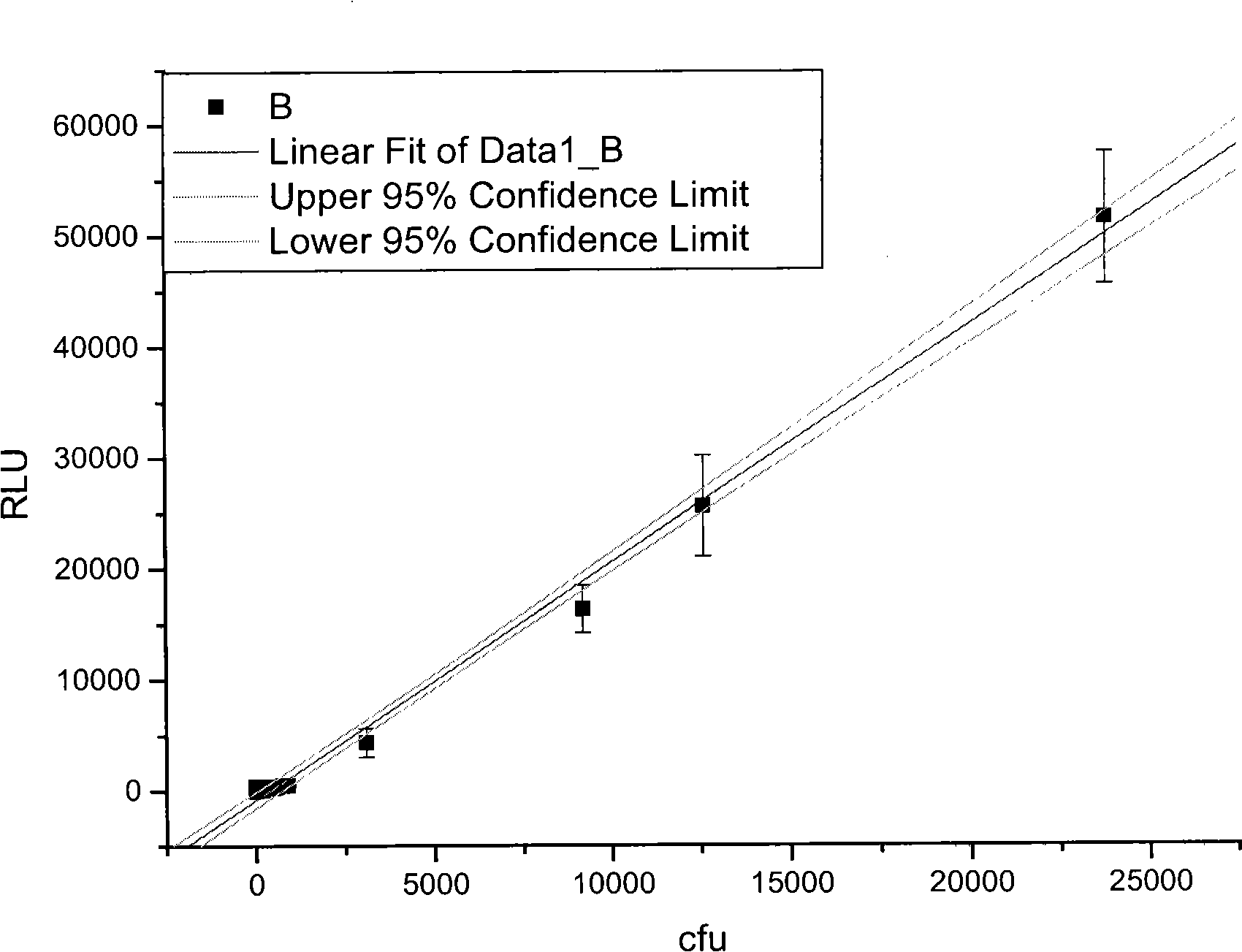Fast detecting method for total number of bacterial colony in flavouring like sauce
A technology for the total number of colonies and detection methods, applied in biochemical equipment and methods, measurement/inspection of microorganisms, analysis through chemical reactions of materials, etc., to achieve rapid detection methods and low detection costs
- Summary
- Abstract
- Description
- Claims
- Application Information
AI Technical Summary
Problems solved by technology
Method used
Image
Examples
Embodiment 1
[0022] 1. Sample filtration Use a pipette to pipette 10ml of liquid food into 90ml of sterile saline, shake well, take 10ml of the diluted sample to pass through a 0.2μm-0.45μm membrane, collect the bacteria, and treat the bacteria trapped on the membrane Rinse three times with sterile normal saline to remove substances in condiments such as soy sauce that affect bacterial repair and interfere with luminescence. The data listed in Table 1 illustrate the presence of substances that interfere with luminescence in soy sauce.
[0023] Table 1 Effects on the luminescent system before and after removing interfering substances
[0024] sample name
relative luminescence value
(RLU, n=3)
Colony Count Results
(cfu / ml)
sample 1
(100μl light soy sauce, 10μl dilution solution + 100μl enzyme solution)
89507±1538
1700
sample 2
(100μl dark soy sauce, 10μl diluent + 100μl enzyme solution)
948±42
140
...
Embodiment 2
[0036] 1. To isolate the bacteria, use a balance to aseptically weigh 10g of solid or paste food into 90ml of sterile saline, shake it well, let it stand for 15min, take 20ml of the supernatant and centrifuge at 600g-1000g / 7min at 4°C to remove For food residues, take 10ml of the supernatant and pass it through a 0.2μm-0.45μm mixed cellulose ester microporous filter membrane, collect the bacteria, and wash the bacteria trapped on the membrane three times with sterile physiological saline to remove the bacteria that affect the repair in the food and substances that interfere with luminescence.
[0037] 2. Repair medium composition and preparation Medium formula: beef extract powder 2g, casein hydrolyzate 20g, soluble starch 0.5g, anhydrous glucose 7g, L-alanine 0.5g, inosine 0.5g, L-asparagine Vegetable 0.5g, add distilled water 1000ml. Sterilize at 121°C for 15 minutes and store at room temperature for use. The culture medium was divided into 180mm×18mm test tubes, 10ml per ...
Embodiment 3
[0041]1. To isolate the bacteria, use a balance to aseptically weigh 10g of solid or paste food into 90ml of sterile saline, shake it well, let it stand for 15min, take 20ml of the supernatant and centrifuge at 600g-1000g / 7min at 4°C to remove For food residues, take a 10ml sample of the supernatant and centrifuge at 6000g-10000g / 7min at 4°C, remove the supernatant, collect the bacteria, wash the bacteria three times with sterile saline repeatedly, and remove the substances in the food that affect bacterial repair and interfere with luminescence .
[0042] 2. Repair medium composition and preparation Medium formula: beef extract powder 5g, casein hydrolyzate 15g, soluble starch 3g, anhydrous glucose 3g, L-alanine 1g, inosine 0.25g, L-asparagine 2g , add 1000ml of distilled water. Sterilize at 121°C for 15 minutes and store at room temperature for use. The culture medium was divided into 180mm×18mm test tubes, 10ml per tube, and sterilized at 121°C for 15 minutes before use. ...
PUM
 Login to View More
Login to View More Abstract
Description
Claims
Application Information
 Login to View More
Login to View More - R&D
- Intellectual Property
- Life Sciences
- Materials
- Tech Scout
- Unparalleled Data Quality
- Higher Quality Content
- 60% Fewer Hallucinations
Browse by: Latest US Patents, China's latest patents, Technical Efficacy Thesaurus, Application Domain, Technology Topic, Popular Technical Reports.
© 2025 PatSnap. All rights reserved.Legal|Privacy policy|Modern Slavery Act Transparency Statement|Sitemap|About US| Contact US: help@patsnap.com


